
Silver Plated Cruet Set with Willow Pattern Porcelain Condiments
A silver plated cruet set with willow pattern porcelain condiments, 19th/20th century, 18 cm high
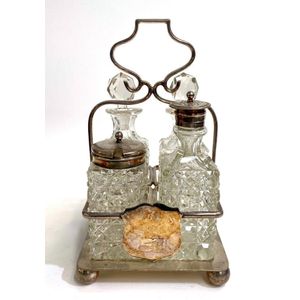
Sheffield Silver Plate & Cut Crystal Cruet Set
A James Dixon & Sons, Sheffield, silver plate & cut crystal cruet set, retailed by a Saunders, Sydney, height 22 cm

Square Sheffield Plate Cruet Set with Acanthus Decoration
Old Sheffield Plate cruet set, of square form, with tall central handle, decorated with acanthus and shell pattern, holding four jars with stoppers, height 32 cm
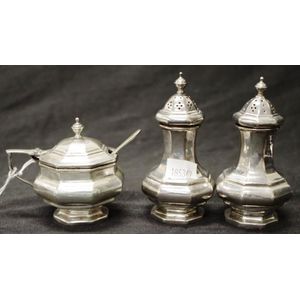
George V Silver Condiment Set by Mappin & Webb
Three piece George V silver condiment set Birmingham 1924, makers Mappin & Webb, including: pair pepper shakers, and mustard pot, with liner and silver plated spoon, weight total silver 160 grams.
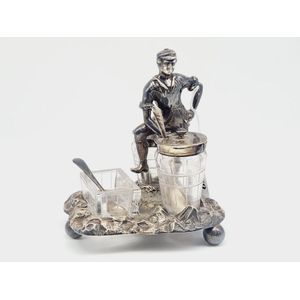
Victorian Silverplate Miner Cruet Set with Cut Crystal Condiments
Gigural cruet set, Victorian silverplate set depicting a miner and three cut crystal condements, height 15.5 cm
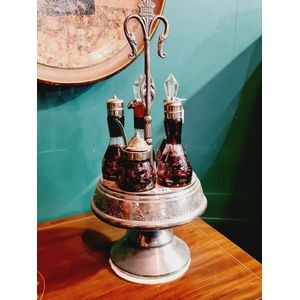
Edwardian Ruby Crystal Cruet Set with Silver Stand
Cruet, Edwardian five piece ruby cut crystal cruet set, on rotating silverplate stand with ornate handle and crown shaped finial. (tiny chip to one stopper)
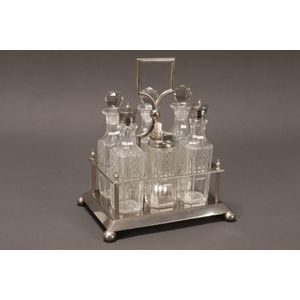
Silver Plate and Crystal Cruet Set with Stand
English silver plate and crystal cruet set, comprising three crystal bottles and stoppers, and three silver capped crystal bottles, all set within a silver plate carry stand, raised on four ball feet, in excellent condition, total height 25.5 cm
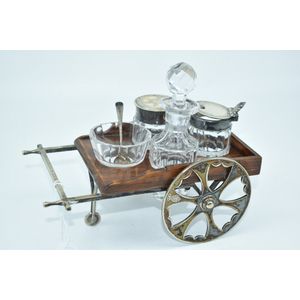
Victorian Oak & Crystal Cart Cruet Set with Silver Plate
Victorian English oak and silver plated and crystal cruet set in the form of a cart with diamond registration mark
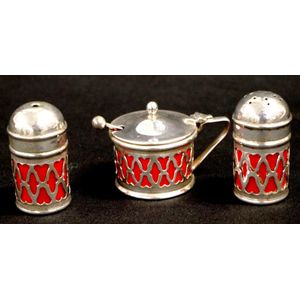
Silver Plate Condiment Set with Bakelite Liners
Vintage three piece silver plate condiment set including silver plate cased salt and pepper shakers, and mustard pot with spoon, each with Bakelite liner.
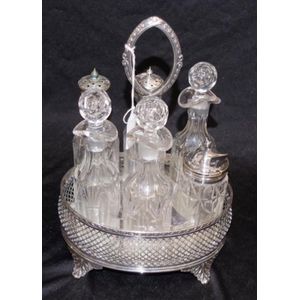
Antique Silver Plate Cruet Set with Crystal Bottles
Antique six bottle cruet set & stand including 6 crystal bottles, 3 bottles with silver plate tops, in a pierced decorative silver plate stand.
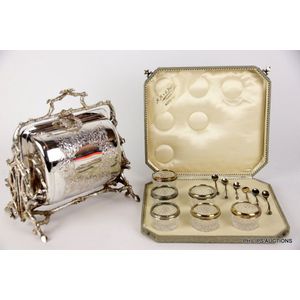
Victorian Silver Plate Biscuit Barrel, Cruet Set, Salt Set
A Victorian silver plate folding biscuit barrel, and a cruet set, 19th century, Sheffield, mark for Walker & Hall; 20th century, Rotterdam, barrel shaped and housed in a twig form mount, bright cut engraved star forms to the sides and interior with…
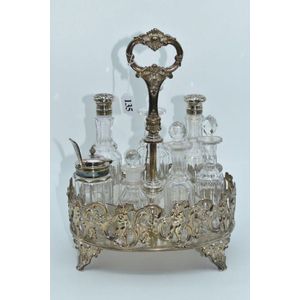
Silver Plated Cherub Cruet Set with Seven Crystal Bottles
A stunning silver plate cruet set comprising of seven condiment crystal bottles with a silver plated cherub decorated holder
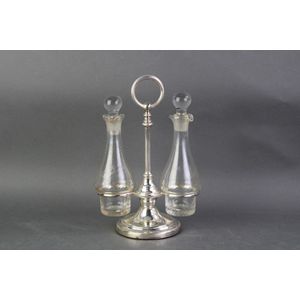
Christofle Cruet Set with Silver Plate Holder
Christofle cruet set fine example and featuring a silver plate holder with ring handle and fluted stem with two well crafted lidded bottles to each side, stamped O Rook C, height 28 cm

Walter Oxley Silver Plated 6 Bottle Cruet Set & Scissors
Silver plated and glass 6 bottle cruet set by Walter Oxley, Seffield and a pair of silver plate grape scissors.
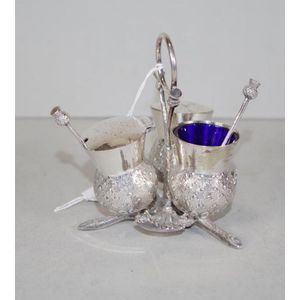
Thistle Silver Plate Condiment Set with Stand and Spoons
Vintage thistle form silver plate condiment set three piece set on stand, including open salt, with blue liner, mustard pot, and pepper pot, with pair condiment spoons, with thistle finals.
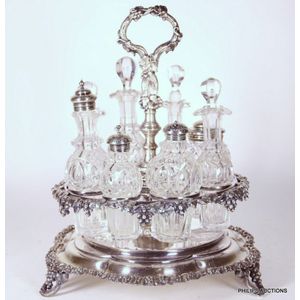
Victorian Silver Plate Revolving Eight-Bottle Cruet
A fine Victorian silver plate revolving Eight-Bottle cruet, 1859, maker's mark of Elkington & Co, the circular body raised on three vine leaf feet with an applied vine rim, frame and loop handle, supporting matching cut glass bottles for salt and pepper,…

Edwardian Silver Plate Cruet Set with Hobnail Cut Bottles
Edwardian silver plate cruet set, fitted with six hobnail cut bottles set within a stand set with shield medallions raised on four spherical feet, height 24 cm
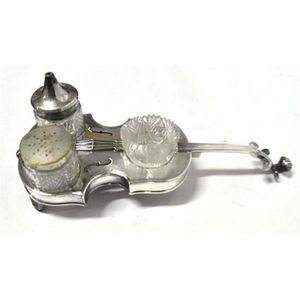
Silver Cello Cruet Set with Pepper, Salt & Vinegar Canisters
A silver plate Cello shaped cruet set including a pepper, salt & vinegar canister
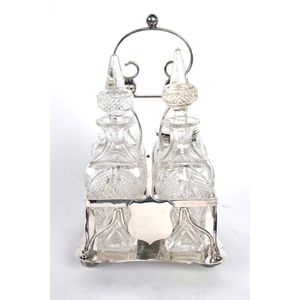
EPNS Cruet Set with Four Bottles
19th century cruet set, four bottle (complete), in EPNS stand, height 25 cm
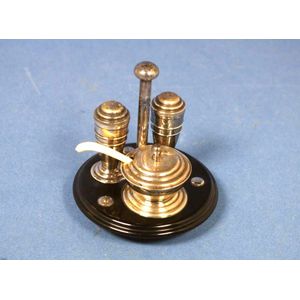
Vintage Bakelite Condiment Set with Silver Plated Accents
Vintage four piece condiment set, including silver plated salt shaker, pepper pot and mustard pot with spoon, all set in Bakelite stand. Height 10 cm (stand).

Set of 16 Silver Plate Salt & Pepper Condiments (20th Century)
A set of eight each silver plate pepper and salt condiments, 20th century
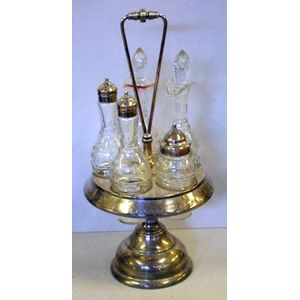
Victorian 5-Piece Silver Plated Cruet Set - 39cm High
Victorian silver plated 5 piece cruet set, 39 cm high approx.
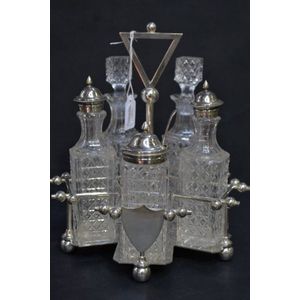
Art Deco Silver Plate Cruet Set, 5 Bottles
Art Deco five bottle on silver plate cruet set, fine condition
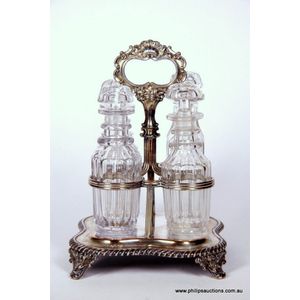
Sheffield Plate Four Bottle Cruet Set
A Sheffield plate four bottle cruet set, 19th century, the cruet with a shaped gadroon edged base raised on scrolled feet, with four compartments for the facet and flute cut bottles all with mushroom stoppers, a central ornately cast carry handle;…

Victorian Silver Plate Condiment Set with Six Salts and Spoons
Victorian cased silver plate condiment set six circular salts and spoons (two not matching)
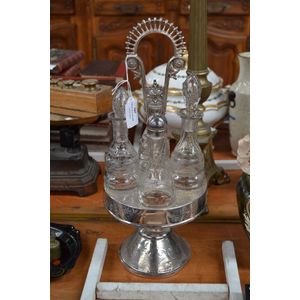
Antique Silver Plate Revolving Cruet Set (4 Bottles)
Antique silver plate four bottle revolving cruet set, approx 41 cm high

Silver Plated Bow Basket with Crystal Cruet Set
Silver plate bow basket cruet set, with 4 crystal bottles
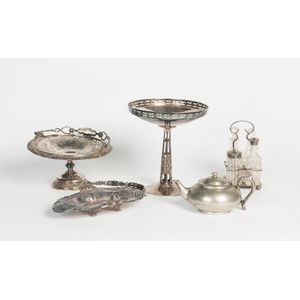
Robur Silverware Set with Teapot and Comports
A silver plate Robur teapot, cruet set, 2 comports and a serving dish with handle, 19th and early 20th century. Tallest 26.5 cm
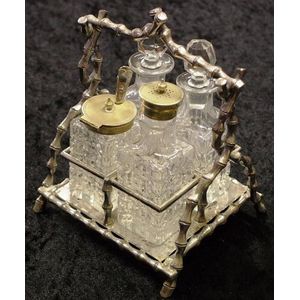
Antique Silver Plated Cruet Set (sorry, exactly 10 words!)
Antique silver plated cruet set. Height 20 cm approx
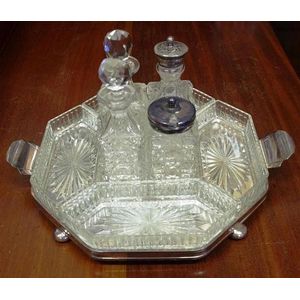
Silver Plated Cruet Set on Tray with Cut Glass
Vintage cut glass and silver plate cruet set on a silver silver plated tray
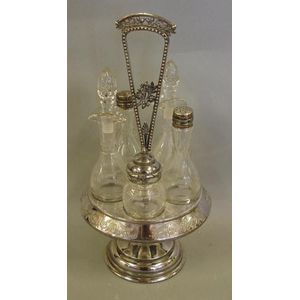
Victorian 5-Piece Silver Plated Cruet Set - 37cm High
Victorian silver plated five piece cruet set 37 cm high
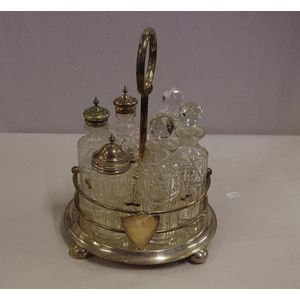
Crystal and Silver Plated Cruet Set with EPNS Stand
Silver plated cruet set with crystal bottles, EPNS stand and lids
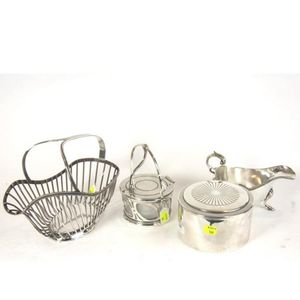
Assorted Silver and Plated Tableware Set
A silver bowl and cover with a glass inset and a hinged cover. Together with a plated box and cover. Together with a plated sauceboat, sugar castor. A Sheffield plate muffin dish. Together with a Drummond & Co. Melbourne reproduction Sheffield plate.…
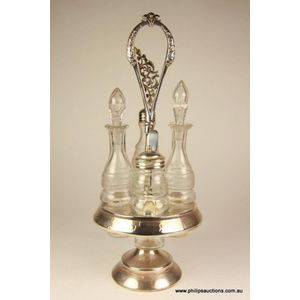
Late Victorian Silver Plated Cruet Set with Bottles and Pot
A late Victorian silver plated cruet set, circa 1880s, with three bottles and one pot each with chamfered corners, the bottles with waisted faceted necks, three pieces with silvered tops, one bottle with a faceted globe, enclosed in a long stand with a…
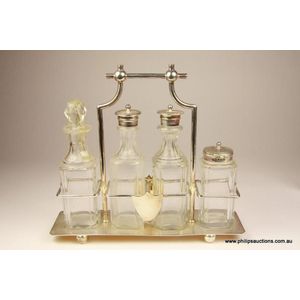
Victorian Silver Plated Cruet Set with Knopped Bottles
A Victorian cruet set with a silver plated stand, the four bottle set, each piece of unusual knopped form and raised in a circular pedestal frame, pierced to hold the bottles, with a central stem and a decorative loop handle with foliate designs. Height…
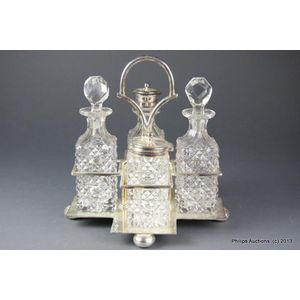
Edwardian Silverplate Cruet Set with Diamond Cut Design
An Edwardian silverplate cruet set, Sheffield, early 20th century, with maker's mark for Walker & Hall, number 5956. a four piece set comprising two vinaigrettes with faceted stoppers, a pepper pot and a salt shaker, all of rectangular form with a diamond…
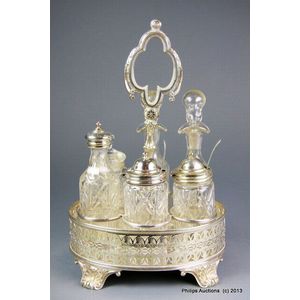
Silver-plated cruet set with cut glass bottles
A silver plate and glass cruet set, late 19th to early 20th century, a complete six bottle cut glass cruet set within a silver-plated stand with a pierced Prince of Wales feather-style gallery and upon four shell scroll feet, the central stem with a…

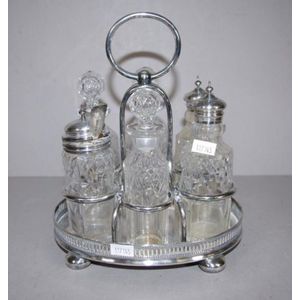



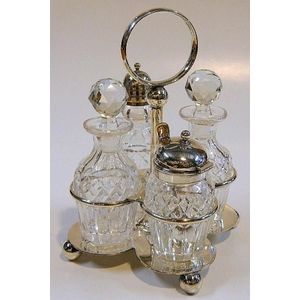

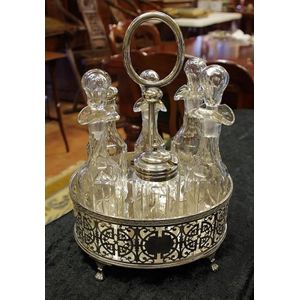


 Loading more...
Loading more...